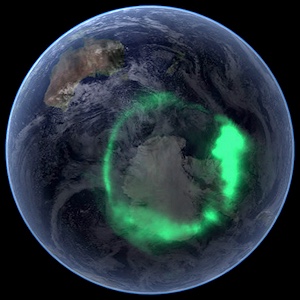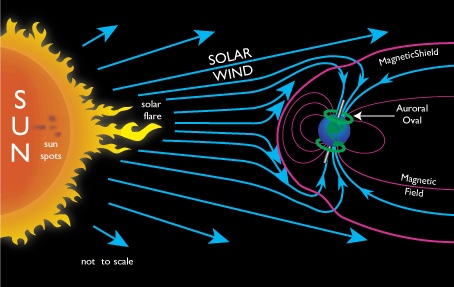What causes the Northern Lights?
The Aurora is an incredible light show caused by collisions between electrically charged particles released from the sun that enter the earth’s atmosphere and collide with gases such as oxygen and nitrogen. The lights are seen around the magnetic poles of the northern and southern hemispheres.
Auroras that occur in the northern hemisphere are called ‘Aurora Borealis’ or ‘northern lights’ and auroras that occur in the southern hempishere are called ‘Aurora Australis’ or ‘southern lights’.
Both Aurora’s can be seen in the northern or southern hemisphere, in an irregularly shaped oval centred over each magnetic pole. Scientists have learned that in most instances northern and southern auroras are mirror-like images that occur at the same time, with similar shapes and colours. Auroral displays can appear in many vivid colours, although green is the most common. Colours such as red, yellow, green, blue and violet are also seen occasionally. The auroras can appear in many forms, from small patches of light that appear out of nowhere to streamers, arcs, rippling curtains or shooting rays that light up the sky with an incredible glow.
What causes the Aurora?
Auroras are the result of collisions between gaseous particles (in the Earth’s atmosphere) with charged particles (released from the sun’s atmosphere). Variations in colour are due to the type of gas particles that are colliding. The most common aurora colour which is green, is produced by oxygen molecules located about 60 miles above the earth. The rarer red auroras are produced by high-altitude oxygen, at heights of up to 200 miles. Nitrogen produces blue or purple aurora.
How do charged particles from the sun get here?
Generally, it is when there is an opening in the suns atmosphere that allows electrons and protons to flow out. In terms of auroras, we need quite a lot of charged particles colliding with earth’s atmosphere to create vivid displays, so this usually requires quite a large opening, such as a coronal hole, or a sunspot. The connection between Auroras and sunspot activity has been suspected since about 1880. Thanks to research conducted since the 1950′s, we now know that electrons and protons from the sun are blown towards the earth on the ‘solar wind’.
When the charged particles are blown towards the earth by the solar wind, they are largely deflected by the earth’s magnetic field. However, the earth’s magnetic field is weaker at either pole and therefore some particles enter earth’s atmosphere and collide with gas particles. These collisions emit light that we perceive as the dancing lights of Auroras.
The lights of the Aurora generally extend from 80 kilometres (50 miles) to as high as 640 kilometres (400 miles) above the earth’s surface.
Thanks to http://www.aurora-service.eu for the content…
Check out my aurora workshops.


